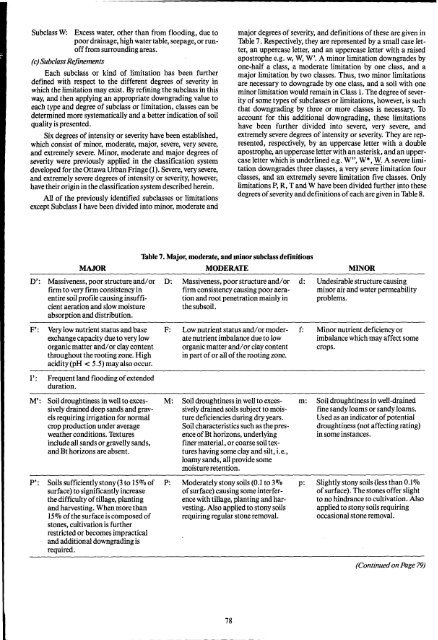The Soils of The Regional Municipality of Ottawa=Carleton
The Soils of The Regional Municipality of Ottawa=Carleton
The Soils of The Regional Municipality of Ottawa=Carleton
Create successful ePaper yourself
Turn your PDF publications into a flip-book with our unique Google optimized e-Paper software.
SubclassW Excess water, other than from flooding, due to<br />
poor drainage, high water table, seepage, or run<strong>of</strong>f<br />
from surrounding areas .<br />
(c) SubclassRefnentents<br />
Each subclass or kind <strong>of</strong> limitation has been further<br />
defined with respect to the different degrees <strong>of</strong> severity in<br />
which the limitation may exist . By refining the subclass in this<br />
way, and then applying an appropriate downgrading value to<br />
each type and degree <strong>of</strong> subclass or limitation, classes can be<br />
determined more systematically and a better indication <strong>of</strong> soil<br />
quality is presented .<br />
Six degrees <strong>of</strong> intensity or severity have been established,<br />
which consist <strong>of</strong> minor, moderate, major, severe, very severe,<br />
and extremely severe. Minor, moderate and major degrees <strong>of</strong><br />
severity were previously applied in the classification system<br />
developed for the Ottawa UrbanFringe (1) . Severe, very severe,<br />
and extremely severe degrees <strong>of</strong>intensity or severity, however,<br />
have their origin in the classification system described herein .<br />
All <strong>of</strong> the previously identified subclasses or limitations<br />
except Subclass I have been divided into minor, moderate and<br />
MAJOR<br />
D' : Massiveness, poor structure and/or D :<br />
firm to very firm consistency in<br />
entire soil pr<strong>of</strong>ile causing insufficient<br />
aeration and slow moisture<br />
absorption and distribution .<br />
F' : Verylow nutrient status and base F:<br />
exchange capacity dueto very low<br />
organic matter and/or clay content<br />
throughout the rooting zone. High<br />
acidity(pH < 5 .5) may also occur.<br />
I' : Frequent land flooding <strong>of</strong>extended<br />
duration .<br />
M' : Soil droughtiness in well to exces- M :<br />
sively drained deep sands andgravels<br />
requiring irrigation for normal<br />
crop production under average<br />
weather conditions . Textures<br />
include all sands or gravellysands,<br />
and Bt horizons are absent .<br />
P' : <strong>Soils</strong> sufficiently stony (3 to 15% <strong>of</strong> P :<br />
surface) to significantly increase<br />
the difficulty <strong>of</strong> tillage, planting<br />
and harvesting . When more than<br />
15% <strong>of</strong>the surface is composed <strong>of</strong><br />
stones, cultivation is further<br />
restricted or becomes impractical<br />
and additional downgrading is<br />
required .<br />
Table 7. Major, moderate, and minorsubclass definitions<br />
MODERATE<br />
Massiveness, poor structure and/or<br />
firm consistency causing poor aeration<br />
and rootpenetration mainly in<br />
the subsoil .<br />
Low nutrient status and/or moderate<br />
nutrient imbalance dueto low<br />
organic matter and/or clay content<br />
in part <strong>of</strong> or all <strong>of</strong> the rooting zone .<br />
Soil droughtiness in well to excessively<br />
drained soils subject to moisture<br />
deficiencies during dry years .<br />
Soil characteristics such asthe presence<br />
<strong>of</strong> Bt horizons, underlying<br />
finer material, or coarse soil textures<br />
having some clay and silt, i .e .,<br />
loamy sands, all provide some<br />
moisture retention .<br />
Moderately stony soils (0 .1 to 3%<br />
<strong>of</strong>surface) causing some interference<br />
with tillage, planting and harvesting<br />
. Also applied to stony soils<br />
requiring regular stone removal .<br />
major degrees <strong>of</strong> severity, and definitions <strong>of</strong> these are given in<br />
Table 7 . Respectively, they are represented by a small case letter,<br />
an uppercase letter, and an uppercase letter with a raised<br />
apostrophe e .g . w, W W' . A minor limitation downgrades by<br />
one-half a class, a moderate limitation by one class, and a<br />
major limitation by two classes . Thus, two minor limitations<br />
are necessary to downgrade by one class, and a soil with one<br />
minor limitation would remain in Class 1 . <strong>The</strong> degree <strong>of</strong> severity<br />
<strong>of</strong> some types <strong>of</strong> subclasses or limitations, however, is such<br />
that downgrading by three or more classes is necessary . To<br />
account for this additional downgrading, these limitations<br />
have been further divided into severe, very severe, and<br />
extremely severe degrees <strong>of</strong>intensity or severity. <strong>The</strong>y are represented,<br />
respectively, by an uppercase letter with a double<br />
apostrophe, an uppercase letter with an asterisk, and an uppercase<br />
letter which is underlined e.g . W", W*, _W.Asevere limitation<br />
downgrades three classes, a very severe limitation four<br />
classes, and an extremely severe limitation five classes. Only<br />
limitations P, R, T andWhave been divided further into these<br />
degrees <strong>of</strong> severity and definitions <strong>of</strong> each aregiven in Table 8 .<br />
d :<br />
f:<br />
m :<br />
p :<br />
MINOR<br />
Undesirable structure causing<br />
minor air and water permeability<br />
problems .<br />
Minor nutrient deficiency or<br />
imbalance which may affect some<br />
crops .<br />
Soil droughtiness in well-drained<br />
fine sandy loams or sandy loams .<br />
Used as an indicator <strong>of</strong>potential<br />
droughtiness (not affecting rating)<br />
in some instances .<br />
Slightly stony soils (less than 0 .1%<br />
<strong>of</strong>surface) . <strong>The</strong> stones <strong>of</strong>fer slight<br />
to no hindrance to cultivation . Also<br />
applied to stony soils requiring<br />
occasional stone removal .<br />
(Continued on Page 79)

















